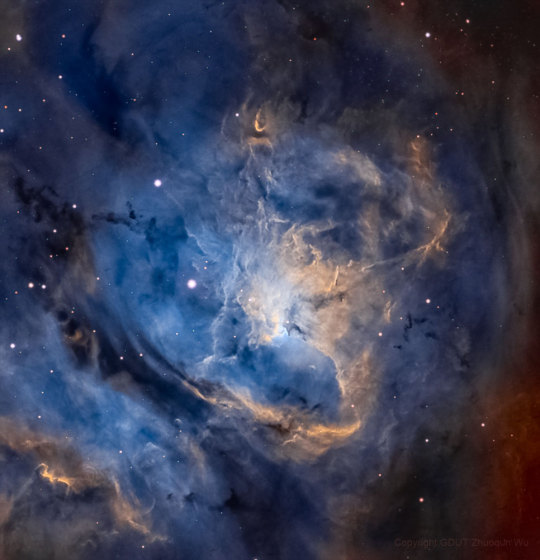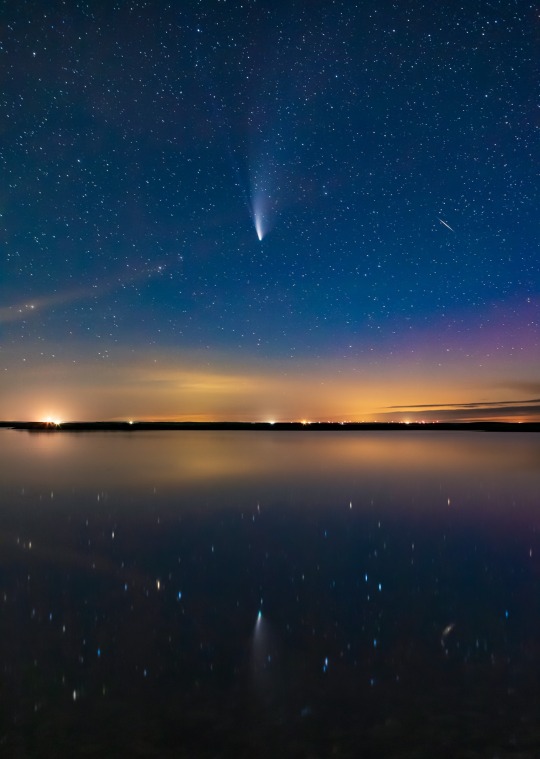Photo

Near the Center of the Lagoon Nebula : Stars are battling gas and dust in the Lagoon Nebula but the photographers are winning. Also known as M8, this photogenic nebula is visible even without binoculars towards the constellation of the Archer (Sagittarius). The energetic processes of star formation create not only the colors but the chaos. The glowing gas results from high-energy starlight striking interstellar hydrogen gas and trace amounts of sulfur, and oxygen gases. The dark dust filaments that lace M8 were created in the atmospheres of cool giant stars and in the debris from supernovae explosions. The light from M8 we see today left about 5,000 years ago. Light takes about 50 years to cross this section of M8. via NASA
3K notes
·
View notes
Photo

Comet NEOWISE Reflection (July 20, 2020)
Credit: Alan Dyer
2K notes
·
View notes
Photo

Comet NEOWISE & Devil’s Table by Sebastian Voltmer
860 notes
·
View notes
Photo

21st Century M101 : One of the last entries in Charles Messier’s famous catalog, big, beautiful spiral galaxy M101 is definitely not one of the least. About 170,000 light-years across, this galaxy is enormous, almost twice the size of our own Milky Way Galaxy. M101 was also one of the original spiral nebulae observed with Lord Rosse’s large 19th century telescope, the Leviathan of Parsonstown. In contrast, this multiwavelength view of the large island universe is a composite of images recorded by space-based telescopes in the 21st century. Color coded from X-rays to infrared wavelengths (high to low energies), the image data was taken from the Chandra X-ray Observatory (purple), the Galaxy Evolution Explorer (blue), Hubble Space Telescope(yellow), and the Spitzer Space Telescope(red). While the X-ray data trace the location of multimillion degree gas around M101’s exploded stars and neutron star and black hole binary star systems, the lower energy data follow the stars and dust that define M101’s grand spiral arms. Also known as the Pinwheel Galaxy, M101 lies within the boundaries of the northern constellation Ursa Major, about 25 million light-years away. via NASA
1K notes
·
View notes
Photo

Crux & Carina at Yerecoin, Western Australia
Nikon d5500 - 35mm - ISO 3200 - f/2.5 - Foreground: 3 x 6 seconds - Sky: 10 x 30 seconds - iOptron SkyTracker
998 notes
·
View notes
Photo


took some more pics of the NEOWISE comet before it fades out over the next few weeks, this time in glacier national park though!
685 notes
·
View notes
Text
Was There Once Life On Mars? Our Perseverance Rover Aims to Find Out
Our Perseverance mission is set to launch on Thursday, July 30 and could help answer many longstanding astrobiology questions about Mars. The mission will deliver our Perseverance rover to the Martian surface, and this powerful rover is equipped with a multitude of tools to study the planet’s environment and to answer questions about whether or not the Red Planet could have had life in the past.

In preparation for launch, our Astrobiology Program is releasing a new update to Issue #2 of the graphic history series, Astrobiology: The Story of our Search for Life in the Universe. This new, fourth edition tells the tale of our exploration of Mars in relation to astrobiology.

The history of our exploration of Mars is full of struggle and triumph. Mars is a dangerous and difficult planet to visit, with frigid temperatures, damaging dust storms, low gravity, and a thin atmosphere. Despite the challenges, NASA missions have opened our eyes to a world that was much more Earth-like in its past, with environments that contained all the necessary conditions for life as we know it.

Issue #2 tells the complete history of our endeavours on Mars, from the Mariner missions to Viking and Pathfinder to Curiosity. In this fourth edition, you’ll find details on the Perseverance rover and its journey to search for ancient signs and signatures of life that could once and for all tell us whether or not life gained a foothold on the ancient Red Planet.

Perseverance will also drill into Martian rocks and collect samples that will one day be returned to Earth by a future Mars Sample Return mission. The samples will be stored in special containers and carefully ‘cached’ in a location on Mars where they will be easily accessible for retrieval. These samples will allow astrobiologists to perform detailed experiments that robots are not yet able to undertake remotely.

Visit astrobiology.nasa.gov/graphic-histories/ to download the new edition of Astrobiology: The Story of our Search for Life in the Universe, and read the entire series to explore NASA’s astrobiology journey to understand the origin and evolution of life on Earth, and the potential for life elsewhere in the Universe!
Make sure to follow us on Tumblr for your regular dose of space: http://nasa.tumblr.com
2K notes
·
View notes
Photo

“In the end, the test of a work of art is our affection for it, not our ability to explain why it is good.”
—Stanley Kubrick, born this day in 1928
2K notes
·
View notes
Photo


The Pyramids of Giza, observed from the ISS on this day in 2012.
2K notes
·
View notes
Photo

Charon at 40: Four Decades of Discovery on Pluto’s Largest Moon by NASA’s Marshall Space Flight Center
350 notes
·
View notes
Photo

A scattering of spiral and elliptical galaxies by Hubble Space Telescope / ESA
220 notes
·
View notes
Photo

Bipolar planetary nebula PN Hb 12 by Hubble Space Telescope / ESA
264 notes
·
View notes
Photo

Hubble sees a cosmic caterpillar by Hubble Space Telescope / ESA
330 notes
·
View notes


